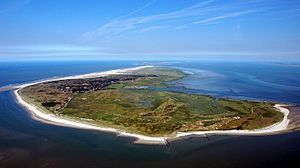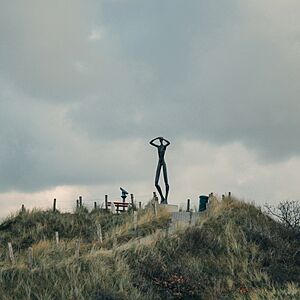Spiekeroog facts for kids
Quick facts for kids
Spiekeroog
|
|||
|---|---|---|---|

Aerial view of Spiekeroog from the west
|
|||
|
|||
| Country | Germany | ||
| State | Lower Saxony | ||
| District | Wittmund | ||
| Elevation | 3 m (10 ft) | ||
| Population
(2022-12-31)
|
|||
| • Total | 841 | ||
| Time zone | CET/CEST (UTC+1/+2) | ||
| Postal codes |
26474
|
||
| Dialling codes | 0 49 76 | ||
| Vehicle registration | WTM | ||
| Website | www.spiekeroog.de | ||
Spiekeroog is an island in the North Sea, off the coast of Germany. It's one of the East Frisian Islands, located between Langeoog to its west and Wangerooge to its east. The island is part of the Wittmund district in Lower Saxony, Germany. The only village on the island is also named Spiekeroog.
Spiekeroog is part of the Wadden Sea, a special natural area recognized by UNESCO as a World Heritage Site. It's also part of the Lower Saxon Wadden Sea National Park. The island covers about 18.25 square kilometers. The closest point to the mainland is 5.7 kilometers away.
Spiekeroog is a car-free island. Only electric mini-cars and emergency vehicles are allowed. A ferry connects the island daily with the German mainland from the harbor of Neuharlingersiel. The island is separated from Wangerooge by a narrow waterway called the Harle.
The name "Spiekeroog" might mean "storage island." This is what most people on the island believe today.
Contents
- Island History: Discovering Spiekeroog's Past
- Tourism: Enjoying Spiekeroog Holidays
- Places of Interest: Exploring Spiekeroog's Landmarks
- Old Island Church: A Historic Building
- Drinkeldodenkarkhof: Cemetery of the Homeless
- Island Museum: Learning About Spiekeroog
- Shell Museum: A World of Shells
- De Utkieker: A Symbol of Nature
- National Park Center Wittbülten: Discovering Nature
- Tidal Flats Tours: Walking on the Sea Floor
- Horse-Drawn Railway: A Fun Ride
- See also
Island History: Discovering Spiekeroog's Past
Spiekeroog was first mentioned in records in 1398. Back then, it was known as Spiekeroch. It was a secret spot for pirates. The islanders sometimes helped the pirates, but the pirates also robbed them!
By 1625, about 13 families lived on the island. They earned a living by farming, fishing, and making muschelkalk (shell-bearing limestone). Later, hunting whales and shipping goods became very important.
During the time of Napoleon, shipping stopped because of a blockade against England. This made the islanders very poor. Smuggling goods to and from Heligoland, which was English territory, became their only way to earn money. In 1812, England attacked the French on the island, but they were pushed back.
Spiekeroog's Journey as a Coastal Resort
In the early 1800s, the idea of coastal resorts became popular in Germany. The first one opened in 1797 on Norderney island. Spiekeroog started welcoming guests for holidays around 1820.
A weekly ferry service from Neuharlingersiel began in 1792. By 1842, ferries started running daily. To make travel easier for visitors, a 1.7-kilometer long horse-drawn railway was built in 1885. It connected the village to the western beach. In 1892, it was extended to a new harbor.
This horse-drawn railway was replaced by diesel trains in 1949. It was the last horse-drawn railway in Germany! In 1981, a new harbor was built, and the diesel train stopped running. But the horse-drawn railway was brought back for tourists. It still operates today!
Tourism: Enjoying Spiekeroog Holidays
Spiekeroog has been a favorite vacation spot for several German presidents. Gustav Heinemann, Richard von Weizsäcker, and Johannes Rau (who even got married on the island) all spent their holidays here.
As a North Sea coastal resort, Spiekeroog offers many health and wellness facilities. These include a wellness center, a mother/child health center, and an island spa.
Spiekeroog can host about 3,500 guests at a time. This includes all hotels, guesthouses, private rooms, vacation apartments, and health centers. In 2003, about 64,000 tourists visited the island each year. They stayed for a total of 554,000 nights. Another 81,000 people visited for just one day. On average, visitors stay on the island for 5.8 days.
Besides hotels and apartments, there is also a campsite. It is located on the western part of the island. The campsite is open from May to September.
Places of Interest: Exploring Spiekeroog's Landmarks
Old Island Church: A Historic Building
The "Old Island Church" is a Protestant church. It was built in 1696, making it the oldest church on all the East Frisian Islands. Inside the church, there is a portrait of the Virgin Mary. People believe it came from a ship of the Spanish Armada that was shipwrecked on Spiekeroog in 1588.
Drinkeldodenkarkhof: Cemetery of the Homeless
The Drinkeldodenkarkhof is also known as the "Cemetery of the Homeless." It is a graveyard for 84 victims. These people died when the ship Johanne sank in 1854.
Island Museum: Learning About Spiekeroog
The Island Museum shows many historical items from Spiekeroog. You can learn about how the coastal resort grew. It also teaches about the nature and wildlife on the island.
Shell Museum: A World of Shells
The Shell Museum is located at Kogge House. It has an amazing collection of 2,000 shells. These shells come from all over the world!
De Utkieker: A Symbol of Nature
Since 2007, a bronze sculpture called „De Utkieker“ has stood on a dune. It is 3.50 meters tall. The German artist Hannes Helmke created it. "De Utkieker" means "The Lookout." It looks out over the sea and symbolizes protecting the island's natural beauty.
National Park Center Wittbülten: Discovering Nature
The National Park Center Wittbülten is two kilometers east of Spiekeroog village. It is surrounded by sand dunes and salt marshes. These areas are covered with beautiful Sea Lavender flowers. The center has an exhibition with a sperm whale skeleton. It also has many interactive displays. These displays help explain the different natural habitats on the island.
Tidal Flats Tours: Walking on the Sea Floor
Tidal flats tours are another popular activity on the island. You can walk across the muddy areas that are covered by water at high tide and exposed at low tide. It's a unique way to explore the Wadden Sea.
Horse-Drawn Railway: A Fun Ride
From April to September, a horse-drawn railway operates on the island. The exact times depend on holiday schedules. It runs between the old railway station and Westend. It's a fun and historic way to see part of the island.
See also
 In Spanish: Spiekeroog para niños
In Spanish: Spiekeroog para niños





